
Autodyne Circuit

An Autodyne circuit integrates three functions typically found in separate stages of an RF Receiver into a single circuit. These three stages are the RF amplifier, the Mixer, and the Local Oscillator, which are usually interconnected. In a standard receiver, each stage would have an individual amplifier. However, in an Autodyne design, the RF amplifier, mixer, and oscillator utilize the same transistor amplifier. The RF amplifier stage is responsible for receiving a signal from the antenna and amplifying it for subsequent circuitry. In this context, the RF amplifier would typically be a low-noise, high-gain transistor amplifier circuit. Following the RF amplifier is the Mixer Circuit, which employs its own transistor or device to combine the RF signal with the signal generated by the local oscillator, subsequently outputting its signal to the Intermediate Frequency (IF) stage. The Local Oscillator circuit is designed to output a frequency that, when mixed with the incoming RF, produces the appropriate Intermediate Frequency (IF) required by the rest of the circuit. Generally, the Local Oscillator (LO) operates as a standalone circuit. The Autodyne circuit merges all three functions into a single design, utilizing one transistor as both the amplifier and the combiner. This circuit amplifies the RF, acts as an oscillator, and mixes the two signals together. The Autodyne schematic serves as an example; the PNP transistor could be replaced with an NPN type, a FET, or any other amplifying component. Furthermore, the Common-Emitter configuration used is just one of three possible transistor configurations. The oscillator style and type could vary, with this particular example appearing to be a Hartley Oscillator. Additionally, feedback methods could be modified as illustrated on the Armstrong Oscillator page. The positioning of resistors used for circuit biasing may also change, and bypass capacitors could be introduced. No specific values are provided, as they would need to be adjusted based on the frequencies involved, including the incoming RF and the LO frequency. Thus, the schematic primarily aims to clarify the concept of an Autodyne circuit without detailing the design process.
The Autodyne circuit exemplifies a compact and efficient design approach in RF receivers by consolidating multiple functions into a single transistor-based configuration. This integration not only simplifies the overall architecture but also enhances performance by reducing component count and potential signal degradation associated with inter-stage connections. The RF amplifier's role is crucial; it must be capable of low-noise amplification to maintain signal integrity before processing. The choice of a low-noise, high-gain transistor is essential as it directly influences the overall sensitivity of the receiver.
The mixing stage is pivotal in converting the amplified RF signal to an Intermediate Frequency (IF), which is easier to process. The use of a transistor or another active device in this stage allows for effective signal combination, leveraging the non-linear characteristics of the device to facilitate the mixing process. The output from the mixer then feeds into the IF stage, where further amplification and filtering occur.
The Local Oscillator generates a stable frequency that is critical for the mixing process. Its design must ensure that the output frequency aligns with the desired IF when combined with the incoming RF signal. The oscillator can take various forms, including the Hartley configuration mentioned, which is known for its simplicity and effectiveness in generating stable oscillations.
Feedback mechanisms within the oscillator can be adjusted to optimize performance, influencing parameters such as frequency stability and output amplitude. The arrangement of resistors for biasing the transistor is another vital aspect, as it determines the operating point of the circuit and affects gain and linearity. The flexibility in component choice and configuration allows for customization based on specific application requirements, including frequency ranges and performance criteria.
In summary, the Autodyne circuit represents an innovative approach to RF signal processing, effectively merging amplification, mixing, and oscillation into a singular design. This efficiency not only simplifies circuit design but also enhances performance, making it a valuable solution in various RF applications.An Autodyne circuit combines three functions normally found in different stages in an RF Receiver into a single circuit. However the three stages which are the RF amplifier, the Mixer and the Local Oscillator are normally found concatenated together.
Although each stage in a normal receiver would have an individual amplifier. In the case of an Aut odyne design, the RF amplifier, mixer and oscillator use the same transistor amplifier The RF amplifier stage is that portion of an RF receiver that receives a signal from the antenna and amplifies the signal so that it is usable by the following circuitry. In regards to this example the RF amplifier would have been a low-noise high-gain transistor amplifier circuit.
The Mixer Circuit would be attached, and follow the RF amplifier and use its own transistor [or other device] to combine the RF signal with the signal generated from the local oscillator. The mixer stage would then output its signal to the IF stage. The Local Oscillator circuit is designed to output a frequency that when mixed with the incoming RF will produce the correct Intermediate Frequency [IF] used by the rest of the circuit.
Normally the Local Oscillator [LO] is designed to function as a stand-along circuit. The Autodyne circuit shown above combines all three functions into a single design, using one transistor as both the amplifier and combiner. The circuit amplifiers the RF, functions as an oscillator and mixes the two signal together. The Autodyne schematic is just an example. The PNP transistor could just as well be an NPN type, a FET or any other amplifying component. In addition, the Common-Emitter circuit used is just one of three possible configurations for a transistor.
The style and type of oscillator could also take any form, this one appears to be a Hartley Oscillator. Also the methods of feed-back could be altered as shown on the Armstrong Oscillator page. Finally the resistors used to bias the circuit could change position, or bypass capacitors could be added.
No values are provided because they would have to change depending on the frequencies involved, the in coming RF, the LO frequency and so on. So in general the schematic is only meant to advance the definition of an Autodyne circuit, without going through the steps needed to design such a circuit.
Editor Comment: Use the dictionary links above or to the right to research any terms or functions used on the pages, or terms that might be related. Each dictionary is it`s own section, with individual links near the top of their pages. Many entries show additional graphics, or variations to different circuits. 🔗 External reference
The Autodyne circuit exemplifies a compact and efficient design approach in RF receivers by consolidating multiple functions into a single transistor-based configuration. This integration not only simplifies the overall architecture but also enhances performance by reducing component count and potential signal degradation associated with inter-stage connections. The RF amplifier's role is crucial; it must be capable of low-noise amplification to maintain signal integrity before processing. The choice of a low-noise, high-gain transistor is essential as it directly influences the overall sensitivity of the receiver.
The mixing stage is pivotal in converting the amplified RF signal to an Intermediate Frequency (IF), which is easier to process. The use of a transistor or another active device in this stage allows for effective signal combination, leveraging the non-linear characteristics of the device to facilitate the mixing process. The output from the mixer then feeds into the IF stage, where further amplification and filtering occur.
The Local Oscillator generates a stable frequency that is critical for the mixing process. Its design must ensure that the output frequency aligns with the desired IF when combined with the incoming RF signal. The oscillator can take various forms, including the Hartley configuration mentioned, which is known for its simplicity and effectiveness in generating stable oscillations.
Feedback mechanisms within the oscillator can be adjusted to optimize performance, influencing parameters such as frequency stability and output amplitude. The arrangement of resistors for biasing the transistor is another vital aspect, as it determines the operating point of the circuit and affects gain and linearity. The flexibility in component choice and configuration allows for customization based on specific application requirements, including frequency ranges and performance criteria.
In summary, the Autodyne circuit represents an innovative approach to RF signal processing, effectively merging amplification, mixing, and oscillation into a singular design. This efficiency not only simplifies circuit design but also enhances performance, making it a valuable solution in various RF applications.An Autodyne circuit combines three functions normally found in different stages in an RF Receiver into a single circuit. However the three stages which are the RF amplifier, the Mixer and the Local Oscillator are normally found concatenated together.
Although each stage in a normal receiver would have an individual amplifier. In the case of an Aut odyne design, the RF amplifier, mixer and oscillator use the same transistor amplifier The RF amplifier stage is that portion of an RF receiver that receives a signal from the antenna and amplifies the signal so that it is usable by the following circuitry. In regards to this example the RF amplifier would have been a low-noise high-gain transistor amplifier circuit.
The Mixer Circuit would be attached, and follow the RF amplifier and use its own transistor [or other device] to combine the RF signal with the signal generated from the local oscillator. The mixer stage would then output its signal to the IF stage. The Local Oscillator circuit is designed to output a frequency that when mixed with the incoming RF will produce the correct Intermediate Frequency [IF] used by the rest of the circuit.
Normally the Local Oscillator [LO] is designed to function as a stand-along circuit. The Autodyne circuit shown above combines all three functions into a single design, using one transistor as both the amplifier and combiner. The circuit amplifiers the RF, functions as an oscillator and mixes the two signal together. The Autodyne schematic is just an example. The PNP transistor could just as well be an NPN type, a FET or any other amplifying component. In addition, the Common-Emitter circuit used is just one of three possible configurations for a transistor.
The style and type of oscillator could also take any form, this one appears to be a Hartley Oscillator. Also the methods of feed-back could be altered as shown on the Armstrong Oscillator page. Finally the resistors used to bias the circuit could change position, or bypass capacitors could be added.
No values are provided because they would have to change depending on the frequencies involved, the in coming RF, the LO frequency and so on. So in general the schematic is only meant to advance the definition of an Autodyne circuit, without going through the steps needed to design such a circuit.
Editor Comment: Use the dictionary links above or to the right to research any terms or functions used on the pages, or terms that might be related. Each dictionary is it`s own section, with individual links near the top of their pages. Many entries show additional graphics, or variations to different circuits. 🔗 External reference





